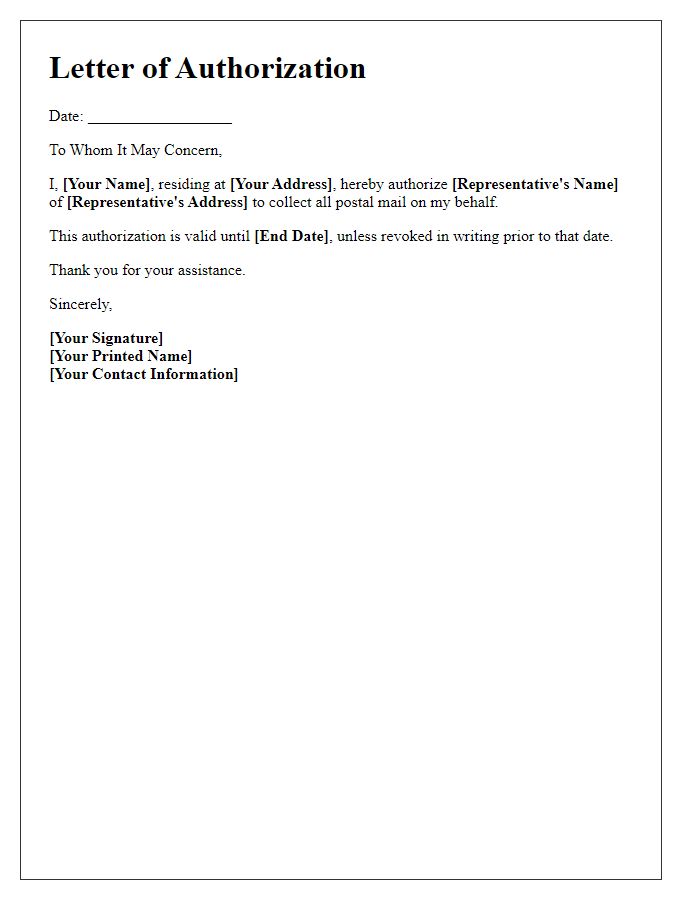Are you looking to streamline your postal mail collection process? Whether you're traveling, managing a busy schedule, or simply need someone to collect your mail on your behalf, having a letter of authorization can simplify things. This handy document ensures that your trusted person can pick up your mail seamlessly while you're away. Dive into the details of how to craft the perfect postal mail collection authorization letter and discover tips for making it effective!

Authorization Details
Authorization details for postal mail collection refer to the permissions granted by an individual or entity, allowing a designated person to collect mail items from a specific postal location, such as the local post office or a postal service provider's facility. Such authorization often includes key information such as the name of the authorizing individual, their identification details (like driver's license numbers or passport numbers), and the full address of the postal location (including street name, city, and postal code). Additionally, the designated collector's full name and identification details should be documented, ensuring a smooth validation process. Dates of validity for this authorization, typically ranging from one week to several months, ensure clarity in time-bound permissions. Collectively, these finely detailed elements serve to prevent unauthorized access to sensitive correspondence or packages.
Recipient Information
Postal mail collection authorization ensures that designated individuals can retrieve important documents or packages on behalf of the intended recipient. For example, an employee may authorize a coworker to collect their mail while on business travel in Seattle, Washington. The authorization process may require details like recipient's full name, address (including ZIP code), and specific identification documents such as a driver's license for verification. Additionally, the designated collector's information should include their name, contact number, and any relevant identification to facilitate a smooth collection process at the local postal office, which in turn helps prevent unauthorized retrieval and ensures confidentiality is maintained.
Sender Information
In the context of postal mail collection authorization, sender information typically includes essential details such as the sender's full name, address, and contact number. For instance, an individual named John Smith residing at 123 Maple Street, Springfield, ZIP code 62704, with a contact number of (555) 123-4567 would provide clarity and identification. This information ensures that postal services recognize the individual authorizing mail collection, verifying authenticity and preventing fraud. Accurate sender information is crucial for smooth processing and delivery of authorized items, making it a pivotal element in mail handling procedures.
Specific Collection Dates
A postal mail collection authorization allows designated individuals to pick up important documents on specific dates. The authorization typically includes details such as recipient name, address details like postal code, and identification requirements to verify the authorized person's identity. Specific collection dates, indicated clearly (e.g., from October 1 to October 7, 2023), help ensure timely retrieval of sensitive materials, reducing the risk of misplacement or delays. Local post offices, such as the United States Postal Service or Royal Mail in the UK, often require official identification, like a government-issued ID, during collection to maintain security protocols. Properly executed collection authorizations enhance efficiency and ensure that vital communication reaches the intended parties without disruption.
Contact Information
Postal mail collection authorization enables designated individuals to collect mail on behalf of another person or organization. This process involves key details such as the authorized person's full name, relationship to the mail recipient, and their identification number (e.g., driver's license or passport). The original recipient's contact information must also be included, specifying the complete mailing address, phone number, and email address for verification purposes. Additionally, the authorization letter should outline the duration of validity for the authorization, ensuring it aligns with expected mail collection dates. Including the date of authorization is crucial to prevent any misunderstandings regarding the timeframe of consent.
Letter Template For Postal Mail Collection Authorization Samples
Letter template of postal mail collection authorization for family member

Letter template of postal mail collection authorization for business purposes

Letter template of postal mail collection authorization for temporary absence

Letter template of postal mail collection authorization for legal representation

Letter template of postal mail collection authorization for house sitter









Comments